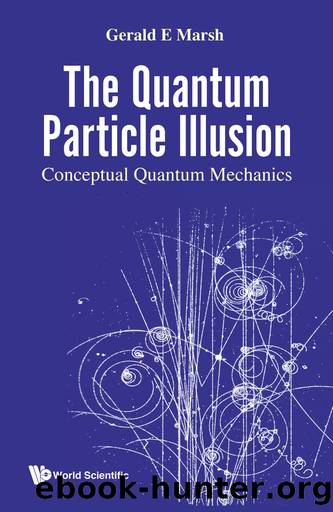Quantum Particle Illusion, The--Conceptual Quantum Mechanics by Gerald E Marsh

Author:Gerald E Marsh [Marsh, Gerald E]
Language: eng
Format: epub
ISBN: 9789811248245
Publisher: World Scientific
Published: 2022-09-15T00:00:00+00:00
Recapitulation
Quantum mechanically, motion consists of a series of localizations due to repeated interactions that, taken close to the limit of the continuum, yields a world-line. If a force acts on the particle, its probability distribution is accordingly modified. This must also be true for macroscopic objects, although now the description is far more complicated by the structure of matter and associated surface physics. The motion of macroscopic objects, as was illustrated in the context of electrostatic forces, is governed by the quantum mechanics of its constituent particles and their interactions with each other. The result may be characterized as such: collective quantum mechanical motion is classical motion.
Since electromagnetic forces may be represented as a gauge field, electrostatic forces arise from the non-constant phase character of the electric field affecting many-particle wavefunctions. The example used was that of the force on a charged or uncharged metallic, conducting sphere placed in an initially constant and uniform electric field.
There is little that is new in this chapter. On the other hand, quantum mechanics is widely viewed as being imposed on the well-understood classical world of Newtonian mechanics and Maxwellâs electromagnetism. This dichotomy is part of the pedagogy of physics and leads to much cognitive dissonance.
In the discussion above, the problems associated with transitioning from the reality of a quantum mechanical, many-body world to a classical one was avoided by using the jellium model â where a metal is modeled as a uniform positive background and an interacting electron gas. This was necessary since few if any many-particle problems with realistic interactions are exactly soluble. The theoretical approach to solving many-body problems often relies on the use of models to obtain approximations to specific problems. But care must be taken to determine the domain of validity of the model. Realistic interactions can create quantum correlations and collective states of matter â such as superfluidity and superconductivity â that have no counterparts in classical physics.
In the end, there is no classical world, only a many-particle quantum mechanical one that â due to localizations from environmental interactions â allows the emergence of the classical world of human perception. Newtonian mechanics and Maxwellâs electromagnetism should be viewed as effective field theories for the âclassicalâ world.
____________________________________
1 See Appendix A.
2 An unusually clear exposition is given by G. F. D. Duff, Partial Differential Equations (University of Toronto Press, Toronto, 1956).
3 Lawrence Sklar, Space, Time, and Spacetime (University of California Press, Berkeley, 1974), p. 328.
4 R. P. Feynman, Phys. Rev. 76 (1949), 749.
5 This is best exemplified by the path integral formulation of non-relativistic quantum mechanics. The latter also has the virtue of explicitly displaying the non-local character of quantum mechanics.
6 The use of the term âlocalizationâ is deliberate. There is no need to bring in the concept of measurements with its implicit assumption of the existence of an âobserver.â It is not necessary that an interaction having occurred, it needs to somehow enter human consciousness in order for the particle to be localized in space and time. The argument that it must enter human consciousness has been used, for example, by Kemble [E.
Download
This site does not store any files on its server. We only index and link to content provided by other sites. Please contact the content providers to delete copyright contents if any and email us, we'll remove relevant links or contents immediately.
| Atomic & Nuclear Physics | Particle Physics |
The Complete Stick Figure Physics Tutorials by Allen Sarah(7339)
Secrets of Antigravity Propulsion: Tesla, UFOs, and Classified Aerospace Technology by Ph.D. Paul A. Laviolette(5336)
Thing Explainer by Randall Munroe(3911)
The River of Consciousness by Oliver Sacks(3574)
The Order of Time by Carlo Rovelli(3164)
How To by Randall Munroe(3077)
A Brief History of Time by Stephen Hawking(2994)
I Live in the Future & Here's How It Works by Nick Bilton(2963)
What If?: Serious Scientific Answers to Absurd Hypothetical Questions by Randall Munroe(2670)
The Great Unknown by Marcus du Sautoy(2664)
Midnight in Chernobyl by Adam Higginbotham(2519)
Blockchain: Ultimate Step By Step Guide To Understanding Blockchain Technology, Bitcoin Creation, and the future of Money (Novice to Expert) by Keizer Söze(2467)
Networks: An Introduction by Newman Mark(2383)
The Meaning of it All by Richard Feynman(2320)
Easy Electronics by Charles Platt(2309)
The Tao of Physics by Fritjof Capra(2247)
Midnight in Chernobyl: The Untold Story of the World's Greatest Nuclear Disaster by Adam Higginbotham(2200)
Introducing Relativity by Bruce Bassett(2098)
When by Daniel H Pink(2098)
